Click on images to enlarge
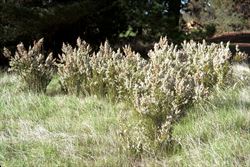
infestation (Photo: Rob and Fiona Richardson)
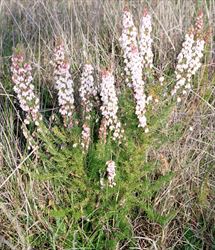
habit (Photo: Rob and Fiona Richardson)
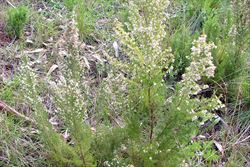
habit (Photo: Sheldon Navie)
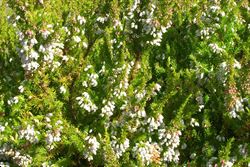
habit (Photo: Forest and Kim Starr, USGS)

close-up of leaves (Photo: Sheldon Navie)
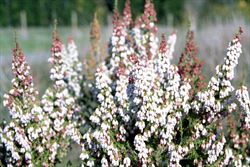
flower clusters (Photo: Rob and Fiona Richardson)
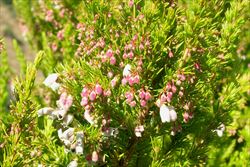
flower buds (Photo: Forest and Kim Starr, USGS)
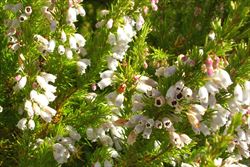
flowers (Photo: Forest and Kim Starr, USGS)

close-up of flowers (Photo: Greg Jordan)
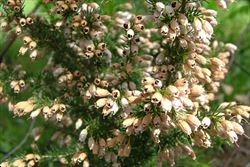
old flowers (Photo: Sheldon Navie)
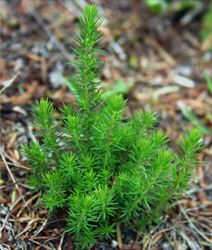
young plant (Photo: Trevor James)
Scientific Name
Erica lusitanica Rudolphi
Family
Ericaceae
Common Names
heath, Portuguese heath, Spanish heath
Origin
Native to south-western Europe (i.e. Spain, southern Portugal and south-western France).
Cultivation
Spanish heath (Erica lusitanica) has been widely cultivated in the temperate regions of Australia. It is still occasionally sold and deliberately cultivated in these regions.
Naturalised Distribution
Spanish heath (Erica lusitanica) is widely naturalised in the south-eastern parts of Australia. It is most common and widespread in Victoria, Tasmania and south-eastern South Australia. Also naturalised in the ACT and in the coastal and sub-coastal districts of southern and central New South Wales.
Naturalised overseas in the UK, New Zealand, Hawaii and south-western USA (i.e. California).
Habitat
A weed of the wetter temperate regions of Australia, particularly those with a "Mediterranean" climate. It infests heathlands, grasslands, coastal environs, grassy woodlands, open woodlands, waterways, pastures, roadsides, disturbed sites and waste areas.
Habit
An upright (i.e. erect) and long-lived (i.e. perennial) shrub usually growing 0.5-2 m tall, but sometimes reaching up to 3 m in height.
Distinguishing Features
- an upright and long-lived woody shrub growing 0.5-3 m tall.
- its tiny narrow leaves (3-7 mm long and less than 1 mm wide) appear to be arranged in groups of three or four along the stems.
- these leaves have margins that are rolled downwards.
- its small tubular flowers (3-5 mm long) have four fused petals and are white or pale pink in colour.
- these flowers turn brown shortly after opening.
Stems and Leaves
The older woody stems are brown in colour and can grow up to 15 cm thick at the base of the plant. The younger stems are slender, green in colour, and covered in hairs (i.e. pubescent).
The tiny leaves (3-7 mm long and about 0.5 mm wide) and crowded together in groups of three or four along the stems (i.e. they appear to be whorled). They are narrow (i.e. linear) or elongated in shape, mostly hairless (i.e. glabrous), and either stalkless or very shortly-stalked (i.e. sessile or sub-sessile). These leaves have entire margins that are rolled downwards (i.e. recurved), producing a lebgthwise (i.e. longitudinal) groove on the lower surface.
Flowers and Fruit
The small tubular flowers (3-5 mm long) are borne in pairs or small clusters of three or four at the tips of very short side branches along the stems (i.e. in lateral racemes). These flowers are borne on short stalks (i.e. pedicels) and hang downwards (i.e. they are pendulous). They are initially pale pink in colour, turn white as they mature, and then eventually turn brown as they age. Each flower has four petals that are fused together for most of their length (i.e. into a corolla tube), with four rounded petal lobes about 1 mm long at their tips. They also have four tiny fused sepals (about 1 mm long), eight dark purple stamens that remain within the flower tube, and a long and narrow style that is topped with a small stigma. Flowering occurs mainly during winter and early spring, but flowers may also be present during autumn and late spring.
The fruit is a small capsule (2-3 mm long) containing 80-100 minute seeds.
Reproduction and Dispersal
This species reproduces via large numbers of minute seeds. These seeds are dispersed by wind, water, animals, vehicles, machinery and in dumped garden waste.
Environmental Impact
Spanish heath (Erica lusitanica) is a significant environmental weed in Victoria, Tasmania and South Australia, and is actively managed by community groups in Tasmania and South Australia. It is also a moderately important environmental weed in New South Wales and the ACT and during a recent survey it was listed as a priority environmental weed in five Natural Resource Management regions.
This species is capable of producing massive quantities of seeds, with a single bush only 0.5 m tall estimated to produce 9 million seeds each year. Spanish heath (Erica lusitanica) can form a dense shrub layer in the understorey of native forests and woodlands in higher rainfall districts, displacing indigenous species and preventing their regrowth. In these situations it can have a serious impact on native ground covers, herbs, grasses and ground orchids.
Spanish heath (Erica lusitanica) is a common environmental weed of the Adelaide region in South Australia, and is particularly well established in the sclerophyll vegetation of the Adelaide Hills. In Victoria it is very widespread and has invaded lowland grasslands, grassy woodlands, dry and wet sclerophyll woodlands, closed forests and riparian vegetation. It is also widespread in Tasmania and is reported to be capable of completely overwhelming the native vegetation, particularly in disturbed habitats. The most significant infestations occur in the northern (e.g. in the Tamar Valley and Meander Valley), north-western (i.e. from Devonport to Smithton), southern (e.g. in the Huon Valley) and eastern coast (e.g. at St. Helens, Bicheno, Swansea and St. Marys) regions of this state. In New South Wales it is chiefly of concern in the Blue Mountains region, where it is locally abundant, but is also present on the central and south coasts.
In New Zealand, Spanish heath (Erica lusitanica) is widely distributed on the North Island and in the northern and eastern parts of the South Island. It has displaced the indigenous manuka (Leptospermum scoparium) in invaded habitats in this country, probably due to a superior ability to survive fire and grazing.
Other Impacts
Spanish heath (Erica lusitanica) can also invade poorly maintained pastures. It is unpalatable to livestock and can therefore reduce the productivity of pastures.
Legislation
This species is declared under legislation in the following states and territories:
- Tasmania: D - the importation or sale of this species is prohibited and measures to reduce its population in an area, eradicate it from an area, or restrict it to a particular area may be required.
- Western Australia: Prohibited - on the prohibited species list and not permitted entry into the state.
Management
For information on the management of this species see the following resources:
- the Victorian Department of Primary Industries Coastal Note on this species, which is available online at http://www.dpi.vic.gov.au.
- the Shire of Yarra Ranges Environmental Weed Fact Sheet on this species, which is available online at http://www.yarraranges.vic.gov.au/Files/12_Fact_Sheet-Spanish_Heath.pdf.
Similar Species
Spanish heath (Erica lusitanica) may be easily confused with other introduced weedy heaths, particularly tree heath (Erica arborea). It is also similar to heather (Calluna vulgaris) and the native species known as common heath (Epacris impressa). These species can be distinguished by the following differences:
- Spanish heath (Erica lusitanica) has simple hairs on its younger stems and tiny narrow leaves (3-7 mm long and less than 1 mm wide) that appear to be arranged in groups of three or four. Its small tubular flowers (3-5 mm long) are usually white or pale pink in colour and turn brown as they age.
- tree heath (Erica arborea) has distinctive branched hairs on its younger stems and tiny narrow leaves (3-5 mm long) that appear to be arranged in groups of three or four. Its small tubular flowers (2.5-4 mm long) are white with darker red (i.e. maroon) coloured throats.
- heather (Calluna vulgaris) has simple hairs on its younger stems and tiny oblong leaves (up to 3.5 mm long) that are arranged in four vertical rows along the stems. Its small tubular flowers (2-4 mm long) are pale purple, bright pink or dark purple in colour.
- common heath (Epacris impressa) has simple hairs on its younger stems and small narrow leaves (4-13 mm long and 1-3 mm wide) that are clearly alternately arranged along the stems. Its relatively large tubular flowers (6-18 mm long) are white, pink or red in colour.

